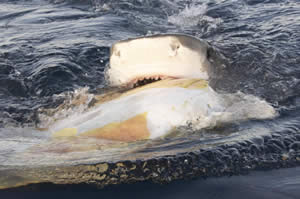
A tiger shark scavenges on the carcass of a green turtle off Raine Island, Australia. Credit Richard Fitzpatrick, BioPixel
An international team that includes University of Miami (UM) Rosenstiel School of Marine and Atmospheric Science researchers found behavioral evidence that tiger sharks prefer to opportunistically scavenge on dead or weakened green turtles rather than actively hunting healthy individuals despite more opportunities to do so. The study, conducted off the coast of Australia during the turtle nesting season, also found the behavior of healthy green turtles suggests that they do not perceive tiger sharks as a major threat during nesting season.
In the new study, the research team used data from satellite tagged tiger sharks and green turtles off the northern coast of Australia's Great Barrier Reef in the waters around Raine Island collected over a five-year period. During some years, up to as many as 12,000 green sea turtles aggregate around Raine Island to lay eggs on the beach, which offers scientists a natural laboratory to compare the movements and behaviors of the turtles and tiger sharks during a time when sea turtle concentrations are higher than average.
"After long nesting periods onshore, many green turtles become weakened from exhaustion. Up to as many as 80 individuals a night may die in certain years, and their bodies eventually get washed into the water during high tide," said study co-investigator Adam Barnett from BioPixel.
They researchers found surfacing of both tiger sharks and green turtles was highest where they overlapped in core home range, closest to the island, and surfacing also increased for both animals with increasing proximity to the shoreline. In other studies where green sea turtles and tiger shark home range overlap have been analyzed, scientists have observed turtles that avoid isolating themselves at the water surface when they are vulnerable to ambush from tiger sharks. Likewise, when tiger sharks are actively hunting turtles, they stalk their prey from deep below to launch a stealthy attack.
"From analyzing the behavioral data from tracked tiger sharks and green turtles, it appears that tiger sharks are patrolling the shores of Raine Island for a few opportunities to scavenge on the few dead turtles that get washed into the water or the weakened individuals that make their way in the water, instead of actively hunting the hundreds of healthy green turtles that they are encountering daily during the turtle nesting season," said the study's lead author Neil Hammerschlag, a research assistant professor at the UM Rosenstiel School and UM Abess Center for Ecosystem Science and Policy. "The sharks are probably having to go out of their way to avoid hundreds of live turtles to find the dead and weakened ones. It is energetically more advantageous and also safer for sharks to scavenge on carcasses rather than have to chase down live turtles. In this way, tiger sharks are similar to terrestrial carnivores, such as hyenas and polar bears, which will selectively scavenge when the opportunity arises."
"Raine Island is the most biologically significant island on the Great Barrier Reef. It is home to the largest sea bird nesting population on the Reef and the largest green sea turtle nesting site in the world," said study co-investigator Richard Fitzpatrick from BioPixel. "To date, lots of research has been done on the turtles and birds. This research has increased our understanding of the predators that use the Raine Island region, and in turn enhanced our understanding of the whole Raine Island ecosystem."
#
The study, titled "Behavioral evidence suggests facultative scavenging by a marine apex predator during a food pulse" was published on August 8, 2016 in the journal Behavioral Ecology and Sociobiology. DOI 10.1007/s00265-016-2183-2. The study's authors include: Hammerschlag and Austin J. Gallagher from the UM Rosenstiel School and Abess Center; Ian Bell from the Queensland Department of Environment and Heritage Protection in Australia; Richard Fitzpatrick and Adam Barnett from BioPixel; Lucy A. Hawkes and Matthew J. Witt from the University of Exeter; Mark G. Meekan and Michele Thums from the Australian Institute of Marine Science; and John D. Stevens from CSIRO Marine and Atmospheric Research.
